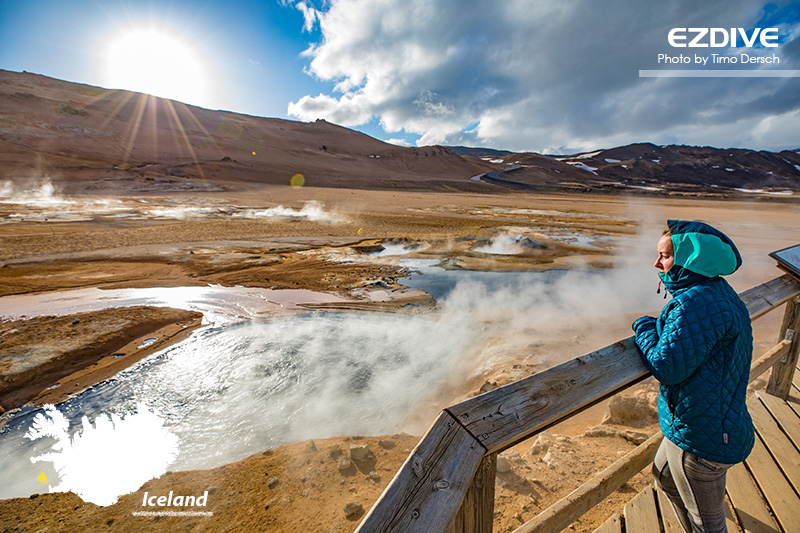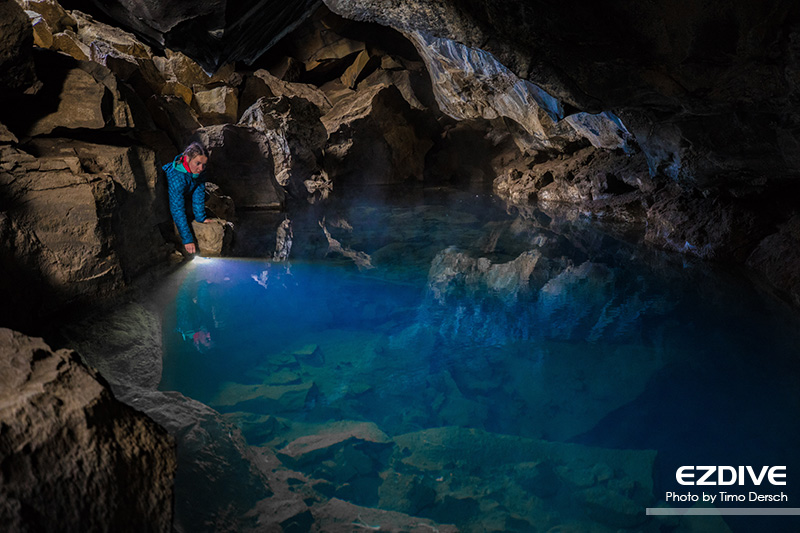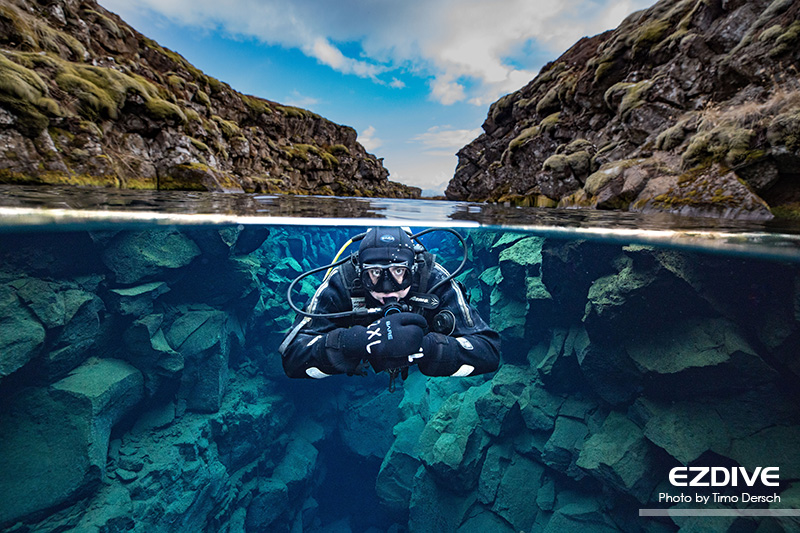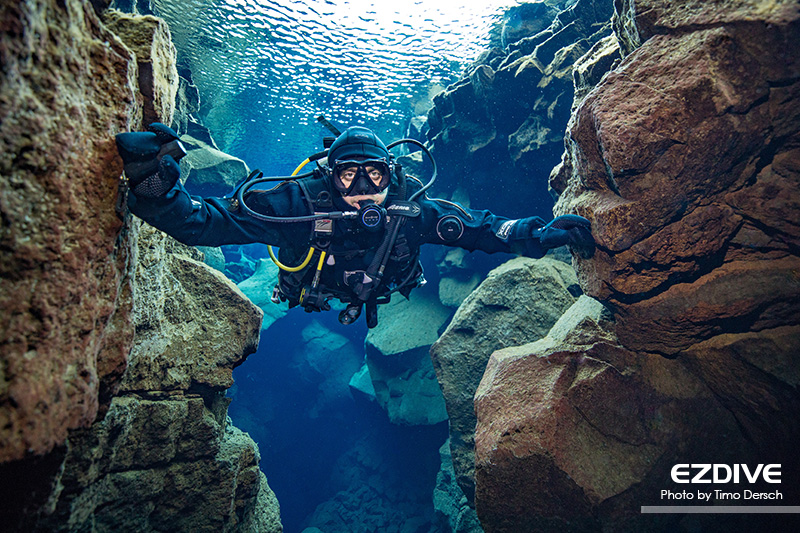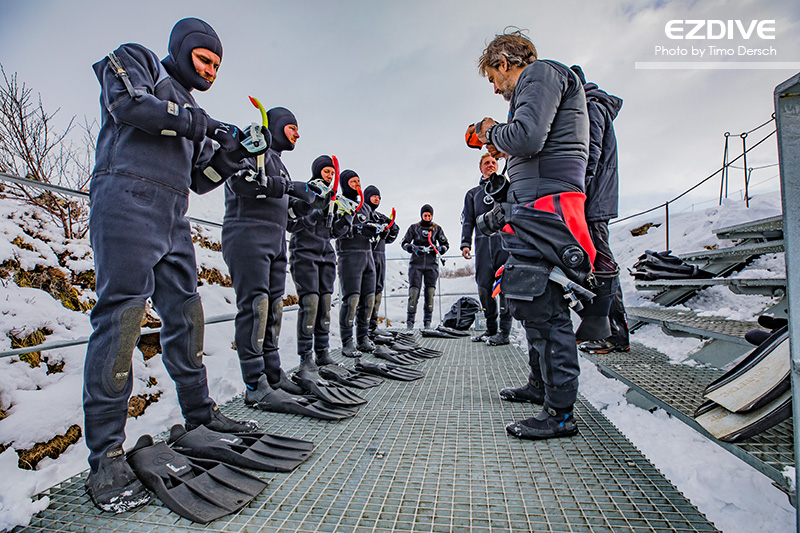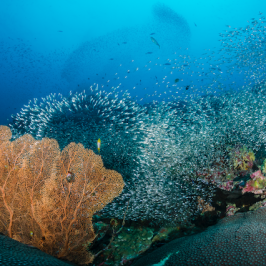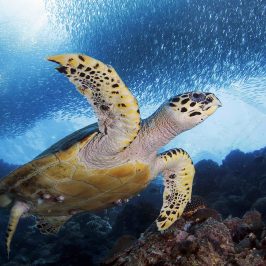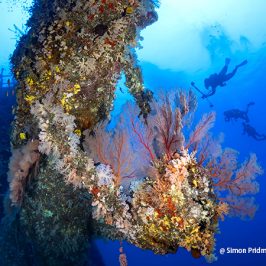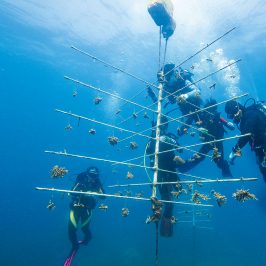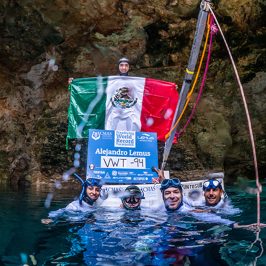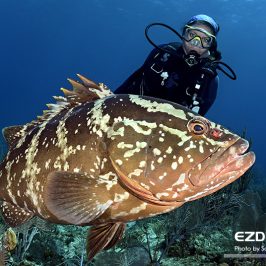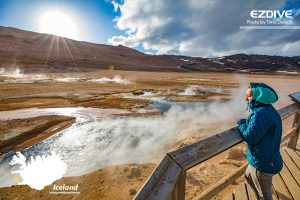
There is one place in the world where you can dive between tectonic plates: Iceland. The crystal clear glacier water, the active volcanoes and this bizarre moon-like landscape make Iceland a dream-like diving destination. Timo Dersch describes what one of the most famous dives in the world feels like.
Text & Photo by Timo Dersch
Do you ever feel like you don’t dive but fly? Yes, everyone refers to the state of zero gravity when speaking about diving and it’s a great experience. It feels like you’re flying, they say.
But let’s be honest. Was diving ever really like flying for you? In the end there is the blurry effect of the reduced visibility and this salty taste of water in your mouth and nostrils.
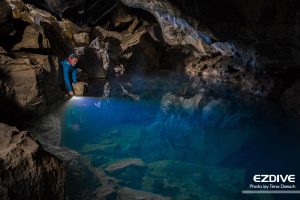 When you stick your head under the water in the Silfra crack, there is nothing but WOW. In the first few seconds, everyone who is visiting the natural site in the Thingvellir National Park is just overwhelmed by the amazing visibility. Your buddies will hear it through your snorkel, or they will hear it through your regulator: a loud sound of amazement is expressed by most of the brave ones who enter the water from the metal steps.
When you stick your head under the water in the Silfra crack, there is nothing but WOW. In the first few seconds, everyone who is visiting the natural site in the Thingvellir National Park is just overwhelmed by the amazing visibility. Your buddies will hear it through your snorkel, or they will hear it through your regulator: a loud sound of amazement is expressed by most of the brave ones who enter the water from the metal steps.
Once you release the air in your BCD and are fully submerged, you have to remind yourself you are not dreaming, that the possibility of flying with a scuba tank has not been invented yet. The water is that clear, you cannot even tell what the visibility is like because you have never experienced anything like this before. It could be 40, could be 60, could be a hundred meters – who knows?
Then there are the shades of blue. There should be a dictionary to describe the different colour tones of blue in these waters. The words we have are not sufficient. Azure blue, dark blue, light blue, carolina blue, indigo, ultramarine, cobalt blue – all of them can be noticed in a glimpse, but there are countless more.
We dive along the crack. There is no other word for it. It is literally a crack in the ground. At the beginning it is around ten meters in depth, later it will have a maximum of 18, with shallower parts in between.
Very soon you arrive at the famous two rocks in this dive. Here, where the two walls of the crack come close enough together, you can touch them both at once – the Eurasian and the American plate – the key photo for every visitor. Look guys, I am touching two continents at the same time – and under the water. You position yourself, and snap, the guide takes the famous shot for you.
But how is it even possible to dive in between two continents? And how is this unique, crystal clear visibility possible? 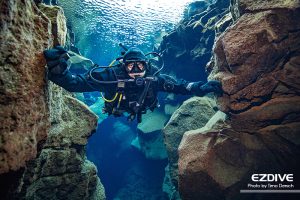 The answers are tectonic drifting and glacier water. The two big tectonic plates of the continents had once met here in Iceland to create a volcanic wonder-world. Now, they are constantly drifting apart, up until seven millimeters each year, leaving the gap in between. Some even say that one day Iceland will be divided in two islands. The key for the visibility is the natural filter system. All the melting glacier water runs through kilometers of volcanic stone. The little bubbly holes in the stone filter out every particle of dirt that could possibly be in the water. Therefore you get the cleanest water imaginable; and the coldest, too.
The answers are tectonic drifting and glacier water. The two big tectonic plates of the continents had once met here in Iceland to create a volcanic wonder-world. Now, they are constantly drifting apart, up until seven millimeters each year, leaving the gap in between. Some even say that one day Iceland will be divided in two islands. The key for the visibility is the natural filter system. All the melting glacier water runs through kilometers of volcanic stone. The little bubbly holes in the stone filter out every particle of dirt that could possibly be in the water. Therefore you get the cleanest water imaginable; and the coldest, too.
The water temperature is 4ºC and you feel it pinching your face like needles, slowly crawling through your gloves making your hands numb, slowly crawling up your neck under your hood. But that doesn’t matter. The dream-like impressions you perceive mean all the physical feelings of cold disappear.
You continue making a turn to the right, passing a very shallow passage where you can stick your head out of the water. You see the snowy mountains in the distance, still not sure whether you are awake or dreaming. Next you reach the deep part; you pause for a bit, let your buddy swim ahead and wonder how tiny he looks in between those massive walls. It ends with a sandy slope and you slightly ascend upwards. Three rocks lie on the sand, beautifully resting there, as if they have been watching the visitors coming through their channel since the beginning of time.
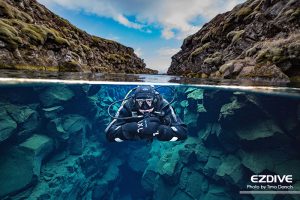 Back in the shallows you turn left and you end up in a round puddle. Here the flying effect is even more stunning because you can see further than inside the crack, which had curves restricting the view to the distance. With the mountains in the background there is a good possibility for a split shot. Sometimes you can even find fish in these waters, your guide Deljan would later explain, “There are three species living in the big lake in which the Silfra water flows into, the Brown trout, the Arctic char and Sticklebacks.” However, only the Arctic Char visit the fissure. They are frequent visitors during mating season in August and September. Throughout the rest of the year, the only fish that live in the Silfra fissure are the Dwarf Char, a subspecies of the Arctic Char, which range in size from a few centimeters, to approximately ten centimeters maximum. They live down in the darker recesses near the rocks and as such are not often spotted by divers or snorkelers. Sometimes they make their way into Silfra, but they don’t like the cold very much so you barely see them. They prefer the warmer, murky water of the lake.
Back in the shallows you turn left and you end up in a round puddle. Here the flying effect is even more stunning because you can see further than inside the crack, which had curves restricting the view to the distance. With the mountains in the background there is a good possibility for a split shot. Sometimes you can even find fish in these waters, your guide Deljan would later explain, “There are three species living in the big lake in which the Silfra water flows into, the Brown trout, the Arctic char and Sticklebacks.” However, only the Arctic Char visit the fissure. They are frequent visitors during mating season in August and September. Throughout the rest of the year, the only fish that live in the Silfra fissure are the Dwarf Char, a subspecies of the Arctic Char, which range in size from a few centimeters, to approximately ten centimeters maximum. They live down in the darker recesses near the rocks and as such are not often spotted by divers or snorkelers. Sometimes they make their way into Silfra, but they don’t like the cold very much so you barely see them. They prefer the warmer, murky water of the lake.
What a dive, what an impression. You are hooked now – to volcanoes, to fresh water, to tectonic plates – and that’s why you follow the call of another secret spot in the north. Where there is less tourism. Where there are crazy sulfur fields and parts of the country that are hardly accessible. There in a very remote bay, you have to cross a farmers’ field to find Nesgjá – the Silfra of the north. There is no infrastructure here. Carefully, to not disturb birds nesting on the edge of the crack, you climb over the stones overgrown with moss. It is a perfect fissure with a wall structure looking like blocks of Lego just placed right next to each other. Again, those shades of blue; again, this crystal clear water that makes you feel like you are flying through this surreal landscape. You find an egg from a seagull. And you take photos as if you were on land. Nesgja is shallower than Silvia. Not more than six meters deep. But this turquoise was worth all the way coming here. It is addictive. If it weren’t so cold, you would dive for three hours in these waters.
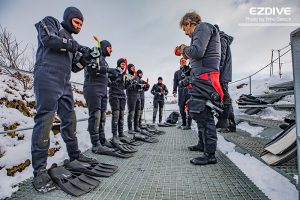
Getting there
Many international airlines, like British Airways, Delta Airlines and Lufthansa fly to Kevlavik Airport. A good option is to fly to Frankfurt and then use the Icelandic low-lost Airline, Wow. Continue from Keflavik with a rental car to Reykjavik.
Language
Icelandic. English is widely spoken.
Currency
Icelandic Krona (ISK). 1 USD = 120 ISK
Electricity
Northern European standard 220 V frequency 50 Hz
Dive Operator
DIVE.IS – www.dive.is

